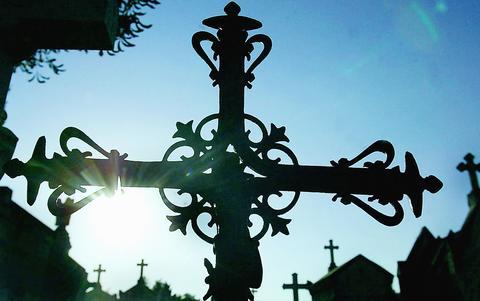The heat wave that scorched Europe in August killed more than 19,000 people, according to official estimates tallied by The Associated Press, making it one of the deadliest hot-weather disasters in a century. The death toll may be higher: the survey of a dozen countries found that two -- Germany and Spain -- have attributed only a fraction of summer fatalities to heat so far.
France -- by far the hardest hit -- on Thursday reported a staggering heat wave death toll of 14,802. Scientists at INSERM, the National Institute of Health and Medical Research, reached the figure by counting the number of deaths over and above what would be expected for the month of August. The toll exceeds an earlier government count of 11,435, a figure based on deaths in only the first two weeks of the month, when Sahara-like temperatures gripped the continent.

PHOTO: EPA
No comprehensive Europe-wide toll exists, and the dimensions of the tragedy may never be known since nations are using different measures to determine heat-related deaths. The French compared the spike in mortality rates this summer to last and attributed the full difference to the record heat.
The AP conducted its survey over the past two weeks, obtaining information from government and nongovernment sources, including national Health Ministries, government statistics offices, mortuaries and ambulance services.
Italy followed the same formula for counting heat deaths as the French. The Health Ministry said 1,176 more Italians died in the first two weeks of August in the nation's 21 largest cities compared to the same period a year ago. The number will surely rise once figures are in for all of August. Italian authorities earlier reported a 4,175-person increase in deaths nationwide for July 16 to Aug. 15.
The Spanish Health Ministry put its official toll at just 141, saying it counted only people whose deaths were specifically attributed to temperature-related conditions such as heatstroke. But the ministry also said there were 4,230 more deaths last month than in August last year.
"Having seen the results from the other countries, 141 seems like an underestimation," said Betina Menne, of the European Global Change and Health Program at the World Health Organization in Rome. She added that WHO had not yet seen the complete study.
In Germany, only 40 people are on official record as dying from the heat. The medical division of the German Weather Service is still compiling a country total, although it is unclear whether the federal government will do the same.
However, an AP survey of government statistics offices, ambulance services and undertakers showed that at least 806 more people died in 15 major cities and two states in August than in the same month last year. Similar figures from the other 14 states were not available.
Some cities suffered far more, as the German example shows.
In Offenbach, near Frankfurt along the Main River, 83 people died in August, compared to only 37 during the same month last year -- an increase of 124 percent. Frankfurt reported a 21 percent rise in the number of deaths in August, from 590 to 714, although city officials haven't blamed the jump on the heat.
Cologne reported a 16 percent increase in deaths in August, 127 more than in the same month last year. Stuttgart showed a 32 percent increase in deaths for August, up to 276 from 209 last year.
Despite difficulties in counting casualties, Europe's heat wave this year stands as one of the deadliest weather phenomena in the last century.

Shamans in Peru on Monday gathered for an annual New Year’s ritual where they made predictions for the year to come, including illness for US President Donald Trump and the downfall of Venezuelan President Nicolas Maduro. “The United States should prepare itself because Donald Trump will fall seriously ill,” Juan de Dios Garcia proclaimed as he gathered with other shamans on a beach in southern Lima, dressed in traditional Andean ponchos and headdresses, and sprinkling flowers on the sand. The shamans carried large posters of world leaders, over which they crossed swords and burned incense, some of which they stomped on. In this

The death of a former head of China’s one-child policy has been met not by tributes, but by castigation of the abandoned policy on social media this week. State media praised Peng Peiyun (彭珮雲), former head of China’s National Family Planning Commission from 1988 to 1998, as “an outstanding leader” in her work related to women and children. The reaction on Chinese social media to Peng’s death in Beijing on Sunday, just shy of her 96th birthday, was less positive. “Those children who were lost, naked, are waiting for you over there” in the afterlife, one person posted on China’s Sina Weibo platform. China’s

‘NO COUNTRY BUMPKIN’: The judge rejected arguments that former prime minister Najib Razak was an unwitting victim, saying Najib took steps to protect his position Imprisoned former Malaysian prime minister Najib Razak was yesterday convicted, following a corruption trial tied to multibillion-dollar looting of the 1Malaysia Development Berhad (1MDB) state investment fund. The nation’s high court found Najib, 72, guilty on four counts of abuse of power and 21 charges of money laundering related to more than US$700 million channeled into his personal bank accounts from the 1MDB fund. Najib denied any wrongdoing, and maintained the funds were a political donation from Saudi Arabia and that he had been misled by rogue financiers led by businessman Low Taek Jho. Low, thought to be the scandal’s mastermind, remains

Australian Prime Minister Anthony Albanese yesterday announced plans for a national bravery award to recognize civilians and first responders who confronted “the worst of evil” during an anti-Semitic terror attack that left 15 dead and has cast a heavy shadow over the nation’s holiday season. Albanese said he plans to establish a special honors system for those who placed themselves in harm’s way to help during the attack on a beachside Hanukkah celebration, like Ahmed al-Ahmed, a Syrian-Australian Muslim who disarmed one of the assailants before being wounded himself. Sajid Akram, who was killed by police during the Dec. 14 attack, and